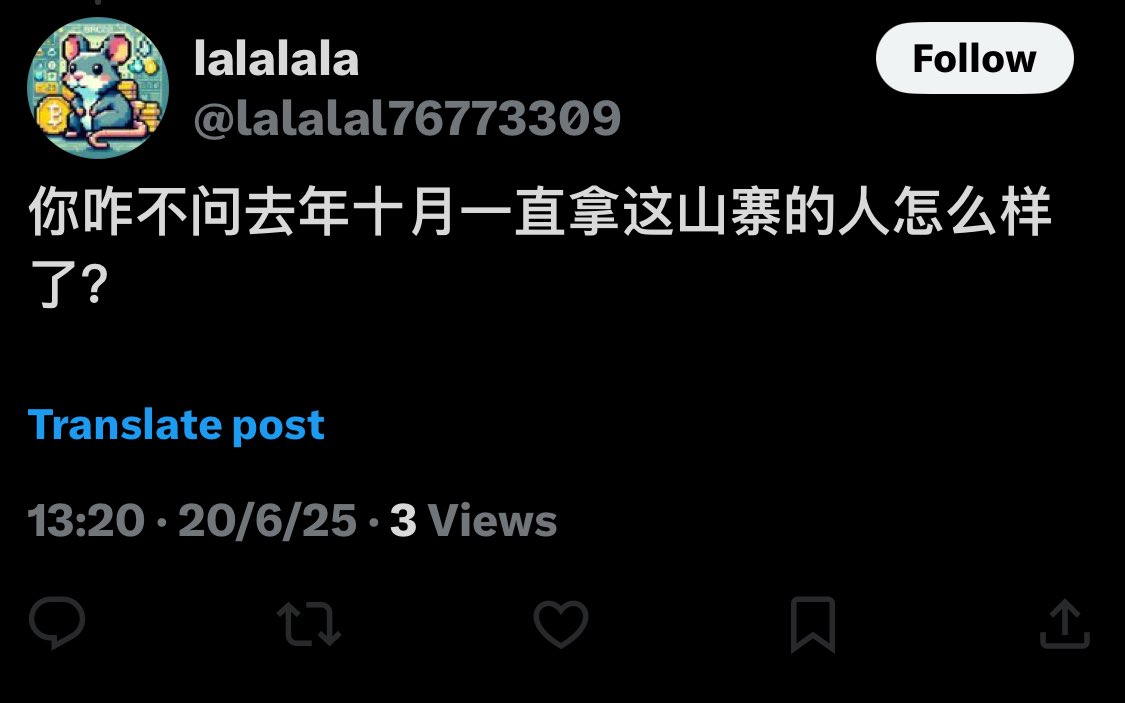
ACT
Act I: The AI Prophecy价格
$0.040810
+$0.0018200
(+4.66%)
过去 24 小时的价格变化

免责声明
本页面的社交内容 (包括由 LunarCrush 提供支持的推文和社交统计数据) 均来自第三方,并按“原样”提供,仅供参考。本文内容不代表对任何数字货币或投资的认可或推荐,也未获得欧易授权或撰写,也不代表我们的观点。我们不保证所显示的用户生成内容的准确性或可靠性。本文不应被解释为财务或投资建议。在做出投资决策之前,评估您的投资经验、财务状况、投资目标和风险承受能力并咨询独立财务顾问至关重要。过去的表现并不代表未来的结果。您的投资价值可能会波动,您可能无法收回您投资的金额。您对自己的投资选择自行承担全部责任,我们对因使用本信息而造成的任何损失或损害不承担任何责任。提供外部网站链接是为了用户方便,并不意味着对其内容的认可或控制。
请参阅我们的 使用条款 和 风险警告,了解更多详情。通过使用第三方网站(“第三方网站”),您同意对第三方网站的任何使用均受第三方网站条款的约束和管辖。除非书面明确说明,否则欧易及其关联方(“OKX”)与第三方网站的所有者或运营商没有任何关联。您同意欧易对您使用第三方网站而产生的任何损失、损害和任何其他后果不承担任何责任。请注意,使用第三方网站可能会导致您的资产损失或贬值。本产品可能无法在所有司法管辖区提供或适用。
请参阅我们的 使用条款 和 风险警告,了解更多详情。通过使用第三方网站(“第三方网站”),您同意对第三方网站的任何使用均受第三方网站条款的约束和管辖。除非书面明确说明,否则欧易及其关联方(“OKX”)与第三方网站的所有者或运营商没有任何关联。您同意欧易对您使用第三方网站而产生的任何损失、损害和任何其他后果不承担任何责任。请注意,使用第三方网站可能会导致您的资产损失或贬值。本产品可能无法在所有司法管辖区提供或适用。
Act I: The AI Prophecy 市场信息
市值
市值是通过流通总应量与最新价格相乘进行计算。市值 = 当前流通量 × 最新价
流通总量
目前该代币在市场流通的数量
市值排行
该资产的市值排名
历史最高价
该代币在交易历史中的最高价格
历史最低价
该代币在交易历史中的最低价格
24 小时最高
$0.041830
24 小时最低
$0.036640
历史最高价
$0.99000
-95.88% (-$0.94919)
最后更新日期:2024年11月14日 (UTC+8)
历史最低价
$0.036520
+11.74% (+$0.0042900)
最后更新日期:2025年6月22日 (UTC+8)
您认为 ACT 今天会涨还是会跌?
您可以点赞或点踩来表达对该币种今日涨跌的预测
投票并查看结果
Act I: The AI Prophecy 动态资讯
以下内容源自 。

rektdiomedes 已转发

The Daily Degen
每日Degen - 2025年6月18日,星期三
战斗、空投、运气、豁免、宏观、视频,以及新项目!
向提到的项目和代币致敬:$AERO, $ACT, $BTC, $FUN, $ZRC, $ETH, $LIQD, $JOE, $HYPE, $CRCL, @vibesdotfun, @hyperbloomxyz, @hypurrML, @extendedapp
同时向提到的关注者超过1万的优秀账号致敬(确保关注他们!):@twindoges(很棒的新项目阿尔法 + 主题),@DynamoDeFi(每日新闻 + 数据),@TheiaResearch(疯狂的加密巨脑)
请转发/等以支持!
下条推文中的链接👇
查看原文
2.13万
27

旧金山不是巴黎
哇哩哇啦一大堆
好像说了很多
又好像什么也没说
抛开这些什么这个盘那个盘的不说
对于大狮兄我单有一点是认同的
就是他给了家庭医生一点钱
你看我
那么向着家庭医生说话
我也没给家庭医生一分钱
他能给家庭医生钱
那就比什么都有用
那就是真义气
我现在对于别人的认同也是取决于
你给不给我钱
例如昨天的@yushuobtc
这位兄弟
我就是非常感谢并且认同的
人家给我打了1000U的 $CA
这比哇哩哇啦说啥都有用
再说回CA
这个币你们看着吧
要翻倍了
之前散户多
现在散户都被折磨下车了
那庄家也要重新拉升搞事了

土澳大狮兄BroLeon
想到前两天和 @jiujinshan2022 巴黎哥关于meme的讨论,我也有在琢磨怎样归纳总结不同时期的meme打法。
我简单提炼一下自己的观点,可能不见得对,欢迎拍砖:
meme 分为纯社区盘(情绪盘)+ 庄盘(逻辑盘)
~~~~~~~~~~·
情绪盘:
情绪盘的特征是不可预测,因为某个突发事件引起人们的情绪共鸣,文化共振等让散户为某个IP买单。
情绪盘起势主要还是在Solana上,目前的P元帅拿到大结果的大都都是在Solana上情绪最好,流动性爆棚的那个阶段。
比如 $Pnut $Moodeng $Goat 等,因为某个热点事件而起,多个标的里快速P出一个最有苗头的,然后大资金进入(多个小庄携手大庄),推波助澜通关CEX,一路打破玻璃天花板获取到了最大的市场流动性,给参与的人带来了暴富机会。
比较明显的还有 $ai16z 带起的Ai Agent那波,机构甚至进场接了早期散户的盘,并最终通过上币安实现了顶级流动性退出。
$Trump 是顶级情绪盘,毕竟美国总统发币这个叙事想象空间太大了,大家当时预期是Trump自己会坐庄这个币,所以一路fomo去到了70+美金。
但事实证明他并没有这个意思,所以情绪过去后直接垮了,这是情绪盘没有成功转移到庄盘。
~~~~~~~~~~~~·
庄盘(逻辑盘)
庄盘的特征是提前由单一庄家(项目方)规划好了发起的全流通meme(有的甚至是部分流通),但因为通过meme平台发射,或者没有VC投资等,都被划分进了meme这一阵营。
早期 $Pepe 起势很久后,竟然都有很多人不知道Pepe是有项目方和团队的,还以为是纯野生。No!绿青蛙也是有庄的,从出生的创意到后面的发展都是有规划的,而且也没掩饰过。
有的meme发射的时候是情绪的,但被单一大户悄咪咪买够控筹后,也变成了庄盘,比如 @MustStopMurad 的 $spx6900
庄盘的优势是,项目筹码结构比较明确,庄家把项目维护好,发展好的动力是最足的,不太容易出现情绪盘那种多个和尚没水喝的局面。( $ACT 就是我参与过的最明显反例,大户们都不干活躺平)
~~~~~~~~~~~~~
对于投资者来说,想要在这两大类meme上拿到大结果,要么你具有超强的工具使用能力/极强的耐心/敏锐的嗅觉,比如 @0xSunNFT @XXAntiWar 这些大手子,在情绪盘金狗出来的早期就抓住。
要么你就把庄盘当做目标,老老实实去做背调,分析清楚庄家的调性,实力,格局,目标,通过逻辑分析判断他们获取进一步流动性的可能,并在合适的位置坐上车。
最近市场上的流动性被 $Trump 被米莱 被 @pumpdotfun 不停的抽走后,情绪盘的博弈空间在变小,进入了垃圾时间。之前赚到钱的大手子们也没有在入场,带走了金山银山(他们的判断是正确的)。
所以我才决定放弃情绪盘圣地Solana,转而专精Bnbchain和Avax,因为这两个链逻辑盘相对更多,分析的空间更大一些。
也因为我实在无法跟20岁的P小将们去博谁能熬,能手快,毕竟中登了已经。🤣🤣🤣
我的优势在于这么多年的项目调研和逻辑锻炼,让我可以比较快速准确的判断庄家的能力强弱,格局大小,战略目标是否能达成,如此而已。
~~~~~~~~~~~~~~~
其实投资meme没有高低贵贱之分,无论情绪盘还是逻辑盘,都是与庄共舞,无外乎是与多个小庄还是与单一大庄而已。
在流动性有限的情况下,我觉得找到自己擅长的节奏和风格,提高胜率是最重要的。你擅长博早期,那么低位进情绪盘吃个信息扩散红利,你擅长投研,可以跟我一样研究逻辑盘,研究庄家的背景和意图。
玩meme需要有情绪,能与大众共鸣,但同时也要保持头脑清醒,不能让自己被情绪裹挟。
怎么说来着?做一个收放自如的渣男(褒义)
11.15万
21
Act I: The AI Prophecy 价格表现 (美元)
Act I: The AI Prophecy 当前价格为 $0.040810。Act I: The AI Prophecy 的价格在过去 24 小时内上涨了 +4.67%。目前,Act I: The AI Prophecy 市值排名为第 228 名,实时市值为 $3,877.37万,流通供应量为 948,244,866 ACT,最大供应量为 1,000,000,000 ACT。我们会实时更新 Act I: The AI Prophecy/USD 的价格。
今日
+$0.0018200
+4.66%
7 天
-$0.00599
-12.80%
30 天
-$0.02285
-35.90%
3 个月
-$0.15429
-79.09%
Act I: The AI Prophecy 闪兑热门币种
最后更新时间:2025/06/22 23:45
| 1 ACT 兑换 USD | $0.040890 |
| 1 ACT 兑换 EUR | €0.035481 |
| 1 ACT 兑换 PHP | ₱2.3378 |
| 1 ACT 兑换 IDR | Rp 671.32 |
| 1 ACT 兑换 GBP | £0.030388 |
| 1 ACT 兑换 CAD | $0.056152 |
| 1 ACT 兑换 AED | AED 0.15017 |
| 1 ACT 兑换 VND | ₫1,068.46 |
关于 Act I: The AI Prophecy (ACT)
此评级是欧易从不同来源收集的汇总评级,仅供一般参考。欧易不保证评级的质量或准确性。欧易无意提供 (i) 投资建议或推荐;(ii) 购买、出售或持有数字资产的要约或招揽;(iii) 财务、会计、法律或税务建议。包括稳定币和 NFT 的数字资产容易受到市场波动的影响,风险较高,波动较大,可能会贬值甚至变得一文不值。数字资产的价格和性能不受保证,且可能会发生变化,恕不另行通知。您的数字资产不受潜在损失保险的保障。 历史回报并不代表未来回报。欧易不保证任何回报、本金或利息的偿还。欧易不提供投资或资产建议。您应该根据自身的财务状况仔细考虑交易或持有数字资产是否适合您。具体情况请咨询您的专业法务、税务或投资人士。
展开更多
- 官网
- 区块浏览器
关于第三方网站
关于第三方网站
通过使用第三方网站(“第三方网站”),您同意对第三方网站的任何使用均受第三方网站条款的约束和管辖。除非书面明确说明,否则 OKX 及其关联方(“OKX”)与第三方网站的所有者或运营商没有任何关联。您同意 OKX 对您使用第三方网站而产生的任何损失、损害和任何其他后果不承担任何责任。请注意,使用第三方网站可能会导致您的资产损失或贬值。
Act I: The AI Prophecy 常见问题
Act I: The AI Prophecy 今天值多少钱?
目前,一个 Act I: The AI Prophecy 价值是 $0.040810。如果您想要了解 Act I: The AI Prophecy 价格走势与行情洞察,那么这里就是您的最佳选择。在欧易探索最新的 Act I: The AI Prophecy 图表,进行专业交易。
数字货币是什么?
数字货币,例如 Act I: The AI Prophecy 是在称为区块链的公共分类账上运行的数字资产。了解有关欧易上提供的数字货币和代币及其不同属性的更多信息,其中包括实时价格和实时图表。
数字货币是什么时候开始的?
由于 2008 年金融危机,人们对去中心化金融的兴趣激增。比特币作为去中心化网络上的安全数字资产提供了一种新颖的解决方案。从那时起,许多其他代币 (例如 Act I: The AI Prophecy) 也诞生了。
Act I: The AI Prophecy 的价格今天会涨吗?
查看 Act I: The AI Prophecy 价格预测页面,预测未来价格,帮助您设定价格目标。
ESG 披露
ESG (环境、社会和治理) 法规针对数字资产,旨在应对其环境影响 (如高能耗挖矿)、提升透明度,并确保合规的治理实践。使数字代币行业与更广泛的可持续发展和社会目标保持一致。这些法规鼓励遵循相关标准,以降低风险并提高数字资产的可信度。
资产详情
名称
OKcoin Europe LTD
相关法人机构识别编码
54930069NLWEIGLHXU42
代币名称
the_ai_prophecy
共识机制
Solana uses a unique combination of Proof of History (PoH) and Proof of Stake (PoS) to achieve high throughput, low latency, and robust security. Here’s a detailed explanation of how these mechanisms work: Core Concepts 1. Proof of History (PoH): Time-Stamped Transactions: PoH is a cryptographic technique that timestamps transactions, creating a historical record that proves that an event has occurred at a specific moment in time. Verifiable Delay Function: PoH uses a Verifiable Delay Function (VDF) to generate a unique hash that includes the transaction and the time it was processed. This sequence of hashes provides a verifiable order of events, enabling the network to efficiently agree on the sequence of transactions. 2. Proof of Stake (PoS): Validator Selection: Validators are chosen to produce new blocks based on the number of SOL tokens they have staked. The more tokens staked, the higher the chance of being selected to validate transactions and produce new blocks. Delegation: Token holders can delegate their SOL tokens to validators, earning rewards proportional to their stake while enhancing the network's security. Consensus Process 1. Transaction Validation: Transactions are broadcast to the network and collected by validators. Each transaction is validated to ensure it meets the network’s criteria, such as having correct signatures and sufficient funds. 2. PoH Sequence Generation: A validator generates a sequence of hashes using PoH, each containing a timestamp and the previous hash. This process creates a historical record of transactions, establishing a cryptographic clock for the network. 3. Block Production: The network uses PoS to select a leader validator based on their stake. The leader is responsible for bundling the validated transactions into a block. The leader validator uses the PoH sequence to order transactions within the block, ensuring that all transactions are processed in the correct order. 4. Consensus and Finalization: Other validators verify the block produced by the leader validator. They check the correctness of the PoH sequence and validate the transactions within the block. Once the block is verified, it is added to the blockchain. Validators sign off on the block, and it is considered finalized. Security and Economic Incentives 1. Incentives for Validators: Block Rewards: Validators earn rewards for producing and validating blocks. These rewards are distributed in SOL tokens and are proportional to the validator’s stake and performance. Transaction Fees: Validators also earn transaction fees from the transactions included in the blocks they produce. These fees provide an additional incentive for validators to process transactions efficiently. 2. Security: Staking: Validators must stake SOL tokens to participate in the consensus process. This staking acts as collateral, incentivizing validators to act honestly. If a validator behaves maliciously or fails to perform, they risk losing their staked tokens. Delegated Staking: Token holders can delegate their SOL tokens to validators, enhancing network security and decentralization. Delegators share in the rewards and are incentivized to choose reliable validators. 3. Economic Penalties: Slashing: Validators can be penalized for malicious behavior, such as double-signing or producing invalid blocks. This penalty, known as slashing, results in the loss of a portion of the staked tokens, discouraging dishonest actions.
奖励机制与相应费用
Solana uses a combination of Proof of History (PoH) and Proof of Stake (PoS) to secure its network and validate transactions. Here’s a detailed explanation of the incentive mechanisms and applicable fees: Incentive Mechanisms 4. Validators: Staking Rewards: Validators are chosen based on the number of SOL tokens they have staked. They earn rewards for producing and validating blocks, which are distributed in SOL. The more tokens staked, the higher the chances of being selected to validate transactions and produce new blocks. Transaction Fees: Validators earn a portion of the transaction fees paid by users for the transactions they include in the blocks. This provides an additional financial incentive for validators to process transactions efficiently and maintain the network's integrity. 5. Delegators: Delegated Staking: Token holders who do not wish to run a validator node can delegate their SOL tokens to a validator. In return, delegators share in the rewards earned by the validators. This encourages widespread participation in securing the network and ensures decentralization. 6. Economic Security: Slashing: Validators can be penalized for malicious behavior, such as producing invalid blocks or being frequently offline. This penalty, known as slashing, involves the loss of a portion of their staked tokens. Slashing deters dishonest actions and ensures that validators act in the best interest of the network. Opportunity Cost: By staking SOL tokens, validators and delegators lock up their tokens, which could otherwise be used or sold. This opportunity cost incentivizes participants to act honestly to earn rewards and avoid penalties. Fees Applicable on the Solana Blockchain 7. Transaction Fees: Low and Predictable Fees: Solana is designed to handle a high throughput of transactions, which helps keep fees low and predictable. The average transaction fee on Solana is significantly lower compared to other blockchains like Ethereum. Fee Structure: Fees are paid in SOL and are used to compensate validators for the resources they expend to process transactions. This includes computational power and network bandwidth. 8. Rent Fees: State Storage: Solana charges rent fees for storing data on the blockchain. These fees are designed to discourage inefficient use of state storage and encourage developers to clean up unused state. Rent fees help maintain the efficiency and performance of the network. 9. Smart Contract Fees: Execution Costs: Similar to transaction fees, fees for deploying and interacting with smart contracts on Solana are based on the computational resources required. This ensures that users are charged proportionally for the resources they consume.
信息披露时间段的开始日期
2024-04-20
信息披露时间段的结束日期
2025-04-20
能源报告
能源消耗
76.24475 (kWh/a)
能源消耗来源与评估体系
The energy consumption of this asset is aggregated across multiple components:
To determine the energy consumption of a token, the energy consumption of the network(s) solana is calculated first. Based on the crypto asset's gas consumption per network, the share of the total consumption of the respective network that is assigned to this asset is defined. When calculating the energy consumption, we used - if available - the Functionally Fungible Group Digital Token Identifier (FFG DTI) to determine all implementations of the asset of question in scope and we update the mappings regulary, based on data of the Digital Token Identifier Foundation.


















